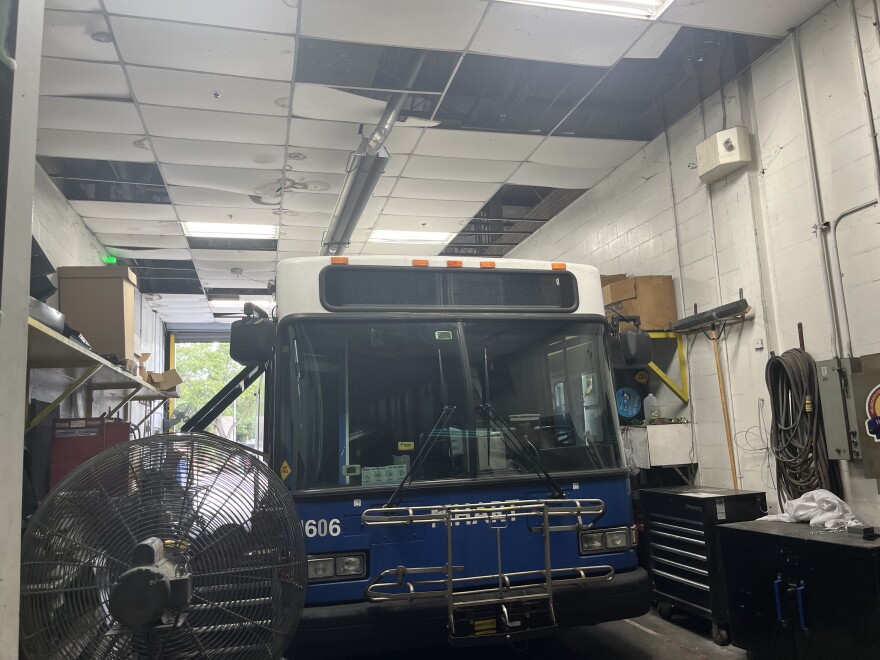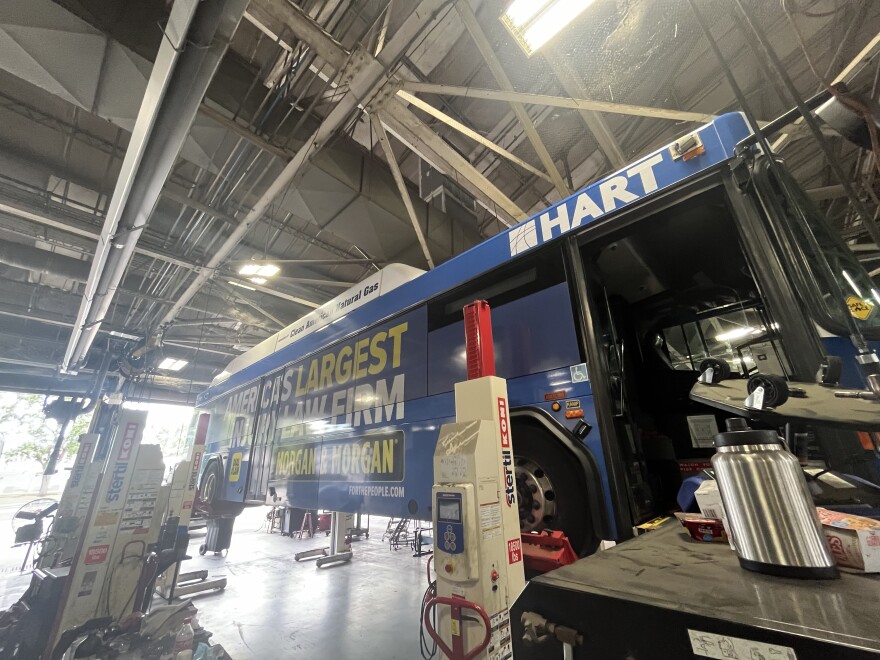If you’ve lived or driven through Hillsborough County, you’ve probably noticed those big blue HART buses. But do you ever think about where those buses go at night?
All of them end the day at Hillsborough Area Regional Transit's heavy maintenance facility, where they get washed, tuned up and ready for another full day of driving.
The leaders of the facility have been asking for a new building to replace the current one, which was originally built for trucks back in the day.
Dale Smith, Dan Rodriguez and Nicholas Goulbourne, three of the people in charge of the facility, discuss how they’ve been able to keep HART’s vehicles running despite some tough facility conditions.

Dale Smith, HART’s director of facilities: This is our heavy maintenance facility. And right here we have our bus wash. This is where we wash our buses every night as they're being serviced. … Here, when they come out of the fuel lane to service, they have to make a 90-degree sharp turn into these two small bus washes. So we constantly are having accidents from them not being able to make the turn or the back of the bus being shorted. And they're running into our bus wash, which is causing us to have to make repairs. They take 30, 60, sometimes 90 days to make the repair.

Dan Rodriguez, HART project manager: This building was originally a trucking facility that was converted over to transit. It's 55,000 square feet, but with that came a lot of inherited problems. So with the building being from 1980, now when we go to renovate it, we couldn't bring it up to code.

DS: This is our parts and inventory area. This is where we store all the parts for the mechanics to come in to replace some parts to do repairs. This is the area that we had water rushing through as a river. The water was probably at least ankle-deep. All the equipment has to be put up on pallets of about 4 inches to protect it from any type of water intrusion when we have these heavy rains.

DS: The forklift is in here. But the forklift is really limited on where it can go. … So we're very limited on what we can do in here. It really creates challenges.
WUSF: Makes you guys creative?
DS: We’re always creative.
WUSF: It seems like, in almost every single aspect, there's just something wrong. So how have you guys navigated this for so many years?
DS: We have to be creative and come up with a solution to make it as safe as we can for our employees. You know, these storms come with major lightning storms. We can't be out in that. So we have to come up with a creative way with another bay, a drive-thru bay, unload it down in the drive-thru bay and then fork it over here when the rain stops. Our business can't stop.

DS: This will actually be a wind tunnel, and that's what knocks out the ceiling tiles. It's just a normal storm. Any kind of storm will come through here so we need to have the doors shut during a storm like that. So that's another thing that we have to really be creative and think about to keep the door shut anytime a storm is approaching.
WUSF: Creativity is the theme?
DS: It is!

Nicholas Goulbourne is responsible for fleet maintenance. In addition to the heat, where the temperature can feel as hot — or even hotter — inside as it is outside, workers also have to deal with cramped conditions.
"Every day," Goulbourne said. "We just don't have the space. It kind of looks like that bent-in pole over there."
WUSF: Oh, there is a bent-in pole. What happened there?
NG: A bus backed into it. It's happened twice so far, so now we put a cone there so people can actually see it as they’re backing up.
WUSF: Is the cone working?
NG: Sometimes.

WUSF: People that are helping keeping these buses running on the street. What are their main gripes? What do you want to see that’s better for them, apart from this space?
NG: A safe working environment where they can feel comfortable. Our mantra is provide clean, safe and reliable public transportation for Hillsborough County, and for my employees I want to provide same thing.

WUSF: What are some of the main hurdles that HART faces when they're trying to get this new facility in the works?
DR: It's twofold, right? So we can apply for federal funding to say, "Hey, we have a ginormous need here." The problem with that is most of the federal funding needs a local match. And our agency is one of the few in the country that does not have a substantial local match, to match the federal dollars.
WUSF: The 2022 tax — the Hillsborough tax ended up failing — would that have provided that money?
DR: That would have provided [enough]. We would have been up and running already.
WUSF: How frustrating was it for you when that didn't pass ultimately?
DR: Extremely. It was heartbreaking. It was heartbreaking.
Following this conversation, HART officials found out the agency was not receiving a federal RAISE grant, as well as a bus facility grant that leaders were hoping for. However, Tampa U.S. Rep. Kathy Castor recently secured federal funds for HART to add new fuel lines to the facility and get Phase 1 of the building replacement project going.
Two days after the tour, it was hit with a heavy storm that caused flooding and knocked out the power at the HART transit operation facility, which allows communication between operators and drivers.




